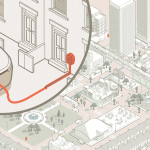NASA/JPL-Caltech
- A NASA helicopter captured photos of the gear that helped the Perseverance rover land on Mars in 2021.
- The images show debris, including a discarded parachute, on the floor of the planet’s Jezero Crater.
- Space junk, left by humans in orbit or on other planets, is growing concern for space agencies.
NASA’s Ingenuity helicopter captured a bird’s-eye view of human-made space junk on another planet — the landing gear that helped it, and the Perseverance rover, get to the red planet.
The 4-pound Ingenuity chopper, the first aircraft to take flight on another world, located and captured photos of the wreckage of a dust-covered, orange-and-white parachute and a backshell — or the protective cover, which stored the chute — from 26 feet in the air. The pictures, which NASA shared Wednesday, were taken on the one-year anniversary of Ingenuity’s first foray into Martian skies on April 19, 2021.
Tasked with searching for signs of ancient life, Perseverance landed on Mars on February 18, 2021, after a 300-million-mile journey that took seven months.
NASA/JPL-Caltech
Officials at NASA’s Jet Propulsion Laboratory said in a statement that the landing gear held up pretty well. The backshell acted as a heat shield to the SUV-sized Perseverance (and the helicopter tucked in its belly) throughout its lengthy trek from Earth. During its descent toward the Martian surface, the rover deployed a parachute to slow it down and stick the landing at Jezero Crater — home to what was once an ancient river delta.
While the backshell ended up in pieces after a fiery plunge at about 78 miles per hour, its protective coating and the suspension lines connecting it to the parachute appear to be intact. Just one-third of the 70-foot-wide chute is visible in Ingenuity’s images, but “the canopy shows no signs of damage from the supersonic airflow during inflation,” the agency said in a statement, adding, “Several weeks of analysis will be needed for a more final verdict.”
Since both pieces of hardware worked as expected, researchers hope studying the components that allowed for a safe landing can help them plan for future space missions. “Perseverance had the best-documented Mars landing in history, with cameras showing everything from parachute inflation to touchdown,” Ian Clark, a former Perseverance systems engineer who now leads the effort to haul Martian samples back to Earth at JPL in Southern California, said in a statement.
“If they either reinforce that our systems worked as we think they worked or provide even one dataset of engineering information we can use for Mars Sample Return planning, it will be amazing. And if not, the pictures are still phenomenal and inspiring.”
The dilemma with high-flying trash
NASA/JPL-Caltech
Space junk — artifacts left by humans in our orbit or on other celestial bodies, including defunct satellites, burned-up boosters, screwdrivers, parachutes, and other leftovers from human space exploration — is a growing concern for space agencies. As more satellites are regularly launched into space, Earth’s orbit is getting more crowded. The problem worsens each year, as old satellites and other objects collide, generating thousands of bits of debris and starting a chain reaction of collisions. That satellite congestion circling Earth raises the risk of orbital collisions and imperils future space exploration.
“Protecting the expanding space environment is critical,” a report from the NASA Office of the Inspector General concluded in January of last year. “The services billions of people rely on daily such as weather forecasting, telecommunications, and global positioning systems require a stable space environment.”
Still, restrictions protecting space from pollution are scant. “My concern and fear is that in 20 years it will be very dangerous to go to space because of the pollution,” Ram Jakhu, associate professor and acting director of McGill University’s Institute of Air and Space Law, told Wired last year.
“We’ve polluted the Earth left, right, and center. We will be doing the same thing in space. There has to be a wake-up call or things are going to be serious.”
Powered by WPeMatico






